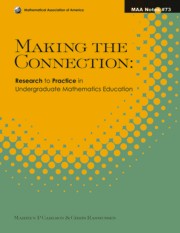Book contents
- Frontmatter
- Preface
- Contents
- Part 1 Student Thinking
- 1a Foundations for Beginning Calculus
- 1b Infinity, Limit and Divisibility
- 5 Developing Notions of Infinity
- 6 Layers of Abstraction: Theory and Design for the Instruction of Limit Concepts
- 7 Divisibility and Transparency of Number Representations
- 1c Proving Theorems
- 8 Overcoming Students' Difficulties in Learning to Understand and Construct Proofs
- 9 Mathematical Induction: Cognitive and Instructional Considerations
- 10 Proving Starting from Informal Notions of Symmetry and Transformations
- 11 Teaching and Learning Group Theory
- 12 Teaching for Understanding: A Case of Students' Learning to Use the Uniqueness Theorem as a Tool in Differential Equations
- Part 2 Cross-Cutting Themes
- About the Editors
12 - Teaching for Understanding: A Case of Students' Learning to Use the Uniqueness Theorem as a Tool in Differential Equations
from Part 1 - Student Thinking
- Frontmatter
- Preface
- Contents
- Part 1 Student Thinking
- 1a Foundations for Beginning Calculus
- 1b Infinity, Limit and Divisibility
- 5 Developing Notions of Infinity
- 6 Layers of Abstraction: Theory and Design for the Instruction of Limit Concepts
- 7 Divisibility and Transparency of Number Representations
- 1c Proving Theorems
- 8 Overcoming Students' Difficulties in Learning to Understand and Construct Proofs
- 9 Mathematical Induction: Cognitive and Instructional Considerations
- 10 Proving Starting from Informal Notions of Symmetry and Transformations
- 11 Teaching and Learning Group Theory
- 12 Teaching for Understanding: A Case of Students' Learning to Use the Uniqueness Theorem as a Tool in Differential Equations
- Part 2 Cross-Cutting Themes
- About the Editors
Summary
Students in many undergraduate mathematics courses tend not to readily and appropriately use theorems as tools for making arguments and solving problems (Schoenfeld, 1989; Hazzan & Leron, 1996). Students' reluctance to use theorems as tools is a problem that is not only cognitive in nature (that is, the difficulty is in how students conceptualize particular mathematical ideas), but also social in nature (that is, the nature of class discussion, the interpretation of tasks and ideas, etc.). In this chapter we highlight results from a classroom-based research program in differential equations that has resulted in some positive progress on the problem of students' reluctance to use theorems as tools for reasoning and solving problems.
The main result of the analysis of student learning and use of the uniqueness theorem for first order differential equations is the delineation of four interrelated cognitive and social factors that help account for why students actually made progress in using the uniqueness theorem as a tool for making arguments and solving problems (Rasmussen, 2004). The intention is that readers might, after understanding the details of this particular case, find the four factors useful more generally as an orienting framework for thinking about ways in which they can promote their students' use of theorems as tools for reasoning in other content areas. Thus, even if one does not regularly teach differential equations, this chapter intends to offer useful information for those who want their students to develop and use formal mathematics with understanding.
- Type
- Chapter
- Information
- Making the ConnectionResearch and Teaching in Undergraduate Mathematics Education, pp. 153 - 164Publisher: Mathematical Association of AmericaPrint publication year: 2008
- 1
- Cited by



